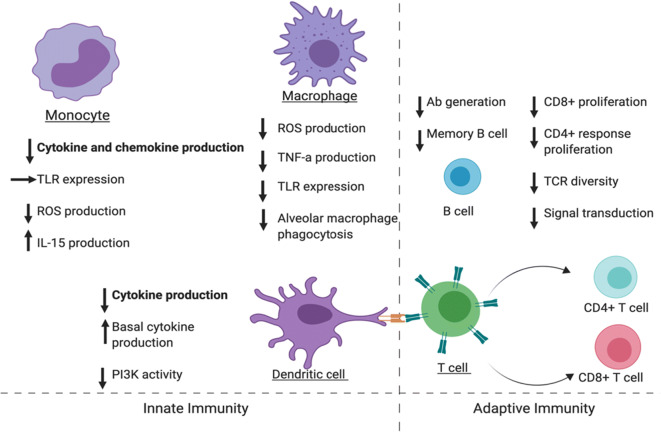Fig. 1.
Cell-specific changes of the innate and adaptive human immune system associated with aging. The effects of aging in various cell types are depicted. With aging, dysregulated innate immune responses can result in failure to efficiently respond to pathogens and vaccines. The production of PAMPs and DAMPs that arise from chronic viral infections and cell damage contributes to the elevated pro-inflammatory state, also known as “inflammaging.” During inflammaging, increased basal levels of pro-inflammatory cytokines are partially a result of dysregulated PRR signaling including TLRs, RIG-I, cGAS-STING, and inflammasome pathways. This increased basal activation in cell types such as monocytes, macrophages, and dendritic cells restricts sensitivity to new pathogens and responses to vaccines, resulting in dysregulated innate immunity and failure to progress to productive adaptive response. Changes in overall TLR protein expression have been reported with other studies reporting on specific cell subsets that expression levels remain the same, but alterations in intracellular signaling proteins like PI3K and MAPK levels decreased. The failure to progress to adaptive immunity takes the form of the overall decline in T and B cells with a reduction in TCR diversity and expansion and a progressive shift to Th2 immunity. The levels of AID, important for class switch recombination, are reduced in B cells, possibly contributing to the poor memory B cell and antibody formation and a decreased response to vaccination. PAMPs, pathogen-associated molecular patterns; and DAMPs, damage-associated molecular patterns; PRR, pattern recognition receptor; TLR, toll-like receptor; RIG-I, retinoic acid-inducible gene I; cGAS-STING, cyclic GMP-AMP Synthase; IFN, interferon; ROS, reactive oxygen species; TNF-α, tumor necrosis factor-α; TCR, T cell receptor; PI3K, phosphoinositide 3-kinase; MAPK, mitogen-activated protein kinase; TCR, T cell receptor; Th2, T helper type 2 cell; AID, activation-induced cytidine deaminase

